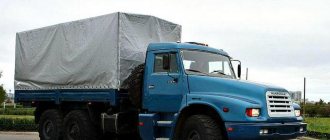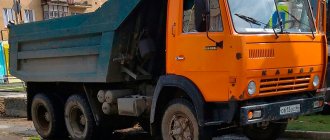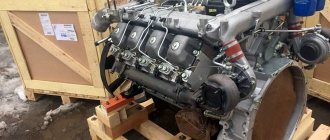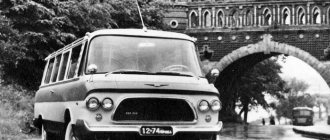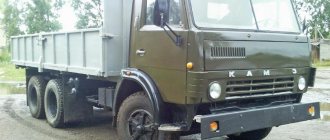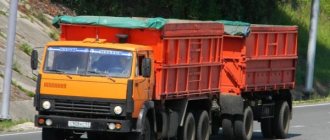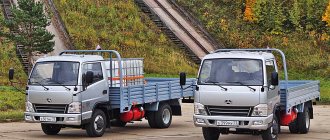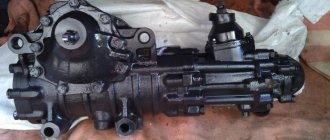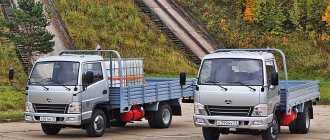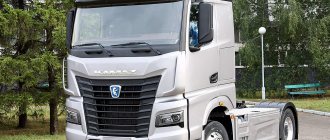In the automotive world, there is still no better way to test new technologies and test design solutions than motorsports. From rallying, Formula 1 and touring car championships, compressors and turbines, direct injection and energy recovery systems came under the hoods of civilian cars, and from there, ordinary drivers got countless electronic assistants. But if for manufacturers of passenger cars the presence of racing teams is natural and understandable, then in the world of freight transport everything is not so obvious.
Kamaz was lucky - it caught the motorsport “virus” from its Volga counterpart, Avtovaz. Mikhail Godzinskoy, transferred from Tolyatti to Naberezhnye Chelny by the decision of the minister to the position of director of an automobile assembly plant, organized an ice racing section there, similar to the one in Tolyatti. It became very popular, and it soon grew into the annual “Inter-Director” ice rally in passenger cars - essentially a team building event for directors of USSR automobile factories and their foreign partners.
The rally was attended, as they would say today, by top managers from all over the country, as well as suppliers of parts from Europe. The level of Chelny motorsport fans is evidenced by the fact that when a buggy section was also opened at the plant, five of its members soon joined the national team, and when the summer rally “Director” was organized in Moscow, by analogy with the “Inter-Director”, it the first winner was the head of the Scientific and Technical Institute Semyon Yakubov, the future leader of the Kamaz-Master team and the navigator of Vladimir Chagin’s crew.
Advertising on Forbes
In January 2022, the Kamaz-Master team won its 15th victory in the truck category of the Dakar Rally·DR
“Truck sport already existed then, and we had a cross-country team at the plant,” recalls Yakubov, “but after one of the members of the Central Committee criticized in the newspaper, saying that trucks should carry cargo, and not chase each other, this direction was covered, and then these trucks stood for a long time in the corner of the yard of the car assembly plant. Then there was an attempt to compete in circuit racing. Painted trucks, girls in swimsuits - everything encouraged participation, and we prepared two cars, but we couldn’t get higher than fifth place. You know, our automobile industry was not the best in the world. I understand that I did not discover America for you, but we felt it ourselves: our engines were weak, we had not yet heard about electronics, everyone had injectors, but we had carburetors, we didn’t even install disc brakes on passenger cars... There was competition hard. And although we won prizes, it was only the audience award; everyone saw how we fought. We skidded through the turns, bypassing our rivals, but on the straights we still fell behind... And then I learned about the Dakar.
Alas, the legend was not able to get to the race right away. Tragedy occurred at the 1988 Dakar: a unique DAF Turbo Twin truck with two engines, each driving a separate axle, was involved in an accident in which the navigator died. That DAF once raced up to 200 km/h during the race and easily overtook both trucks and cars, but the tragedy forced the organizers to introduce restrictions: only production models could now participate in the truck class. So the first international starts of the Kamaz-4310 rally took place at the Jelch rally and the Objective Sud rally, at each of which Soviet trucks took second and third places. In 1990, trucks were allowed to participate in the Dakar with certain restrictions.
"Kamaz-Master" 4326
Classic supercars are capable of striking only on ideal roads, but the Russian supercar from the Blue Armada is ready to fly without disassembling the road. Deserts and rocks, swamps and snow fields - all this is his natural habitat. These are the technologies that provide the Kamaz-Master truck with superiority on any surface.
Engine
16-liter V8 Liebherr D9508, 950 hp. With. with a torque of 4500 Nm. At first, combat vehicles used 305-horsepower 11-liter V8 Kamaz-7403, but in the fire that destroyed the engine plant, the Dakar combat units undergoing training there were also killed, so the team had to temporarily switch to 14-liter 520-horsepower Cummins N14- 500E, after which the almost 20-year era of engines from the Yaroslavl and Tutaevsky Motor Plants began - YaMZ and TMZ 7E846/7/8, with a volume of 18 liters and a power of 850 hp. With. and with a torque of 2700 Nm (modifications of these engines can be found on Belaz mining dump trucks, river tugs and locomotives). Heavy and voracious, but indestructible and omnivorous, they easily coped with any fuel and were replaced only after the introduction of volume restrictions at the Dakar. They were replaced by a 13-liter Cummins ISZ-13 and a 16-liter Liebherr D9508, with 920 and 980 hp. With. respectively. Kamaz-Master purchases serial engines, after which it boosts and rebuilds the engines in its Scientific and Technical Center. The scale of the improvements is indicated by the fact that after them the power approximately doubles.
D.R.
Weight
10.2 tons. For comparison: the first truck weighed 10.5 tons, and in the history of the team there was also a 12-ton monster. To make the car lighter, they use all sorts of tricks - for example, cutting off the bolts that secure the wheels. The minimum weight allowed under the regulations is 8.5 tons.
Cabin
Changing the cockpit during the race is prohibited, but changing the engine, axles, transmission and other key parts is possible. During the truck design stage, the size and location of the cab depends on the engine chosen. In the near future, the place of the German engine will be taken by Kamaz, which is now undergoing final tests.
Radiator
January in South America is hotter than in Africa. Therefore, the cooling system was redone, because the speed of the car depends on the oil temperature.
Speed
Maximum speed is 165 km/h, acceleration to 100 km/h in 9.8 seconds.
Transmission
16-speed ZF.
Advertising on Forbes
D.R.
Approach angle
Officially, the maximum is 60°, but the pilots assure that a steeper climb can be taken while moving.
Fan
Despite the heat (40–45 °C), there is no air conditioning in the cabin - it would not withstand the shaking, would increase the weight of the car and take away some of the power from the engine. Three fans with rubber blades are responsible for cooling (to prevent them from breaking and causing injury). The temperature in the cabin during the race reaches 55 °C, while the pilots are dressed in fireproof suits. You can’t drink a lot of water so that you don’t have to stop later. “It’s impossible to eat on the go - everything will jump around the cabin, and then in the stomach,” says Vladimir Chagin, head of the Kamaz-Master team and seven-time winner of the Dakar Rally. “We drink two sips, no more.”
Fuel tank
Advertising on Forbes
A 1000 liter tank is mounted above the rear axle to counterbalance the engine that loads the front axle.
Tires
Continental HCS 14R20 tires participate in the suspension; the pressure in them can be changed in the range from 2 to 7 atmospheres directly from the cab. There are breakdowns at the race every day, and during a rally raid each truck uses up to 18 tires; in total, the team changes from 300 to 320 tires during the season.
Suspension
Reiger Racing sports struts with adjustable stiffness at one time replaced the shock absorbers from the BMD (landing combat vehicle). The design of the struts was modified by the manufacturer in accordance with the requirements of KAMAZ workers, who after the races saw the potential for improving parts and proposed a design solution.
Advertising on Forbes
Devices
In addition to the usual instruments in the cockpit, each crew member has his own equipment. The navigator has GPS and Terra Trip, which provide accurate data about the location of the car. The mechanic has 24 temperature sensors of different components, which show where overheating begins, which usually precedes a breakdown. The pilot has speed control lamps above the windshield. The speed on the Dakar is limited to 140 km/h; when approaching this indicator, the lamps light up one by one - this means that you cannot accelerate any further. In addition, there is a device in front of the driver that informs that a faster car is approaching from behind, which, according to the rules, must be allowed to pass. In 1997, the signal from this sensor was ignored by the pilot of a jeep walking in front of the car of Chagin, Yakubov and Savostin; in the dust, the Kamaz-Master team did not see the turn and the car overturned four times, which almost cost the crew their lives.
Technical changes: new turbine, weight distribution, improved visibility and satisfied riders
The main work on testing, fine-tuning and tuning of the new product was taken by the crew of Sotnikov, the main KAMAZ suspension specialist among the racers. It was thanks to his efforts that the racing K5 was given the ideal weight distribution, steering and improved turbocharger after special tests at high altitudes.
“It would seem that we just changed the cabin, but this forced us to move the engine back, change the suspension settings of both the car and the cabin itself, and in addition, the weight distribution changed,” said the champion. – We have arrived at an almost ideal weight distribution along the axles – 50:50, which is what we have always achieved. The car began to handle better.
Since regulations now allow fenders and floor cutting, this allowed us to lower the cockpit as low as possible and push it further back. In order not to increase the height even further, we decided to use the ceiling as engine air intakes: in the [previous champion] KAMAZ-43509 they rise behind the cabin, and in the K5 they pass directly under the ceiling inside.
The air flow is directed by a sun visor from the outside, which required serious work with aerodynamics: the optimal flow through the cabin was calculated on the computer so that the engine receives as much air as necessary. We also looked at the behavior of the air under and behind the cabin.”
After the first tests of K5, Eduard Nikolaev was also happy - and immediately noticed the improvements.
“The first feeling: we don’t go to work in vain! New cars are getting faster, which is the most important thing. This immediately gave inspiration, and the decision was made to build a second car.
The transition to a new cabin has improved visibility: both the windshield and side windows are now higher, giving the crew an almost panoramic view. This greatly helps the pilot when storming sand dunes.
When the guys from Sotnikov’s crew drove the new truck for the first time, they immediately began to say that it was a very good overview. It helps add pace but still make the sharp rocks visible. It's also great for navigation and navigator work. Well, in general, the cabin has become more spacious, which allows you to keep up the pace.”
The body was also changed: to maintain and improve weight distribution, even more skin parts were transferred to composite materials - just like in the best Audi prototypes and all kinds of Formula cars.
For personal use
DR
Sports Kamaz can be ordered at the plant in Naberezhnye Chelny. A new truck will be built in 9 months (the team produces 2-3 vehicles per year and sells one), or you can reserve one of the team’s vehicles and buy it back after it is written off. In this case, it is possible to get, for example, a truck that won the Dakar. In both cases, the truck can be legally used on public roads. While waiting for a car or after purchasing it, you can take a driving course with the Kamaz-Master team.
The price of a combat Kamaz is €600,000–800,000.
“You can hardly feel the speed in the truck, and you need to get used to it, besides, the capabilities of the vehicle are usually higher than the capabilities of the pilot, and you need to learn to feel the line beyond which it is better not to cross,” advises the head of Kamaz-Master, Vladimir Chagin. Among the buyers of Kamaz trucks there are even Arab sheikhs, for whom the desert for full-fledged off-road trips is literally at arm's length.
- Drown €1,000,000 in mud: rally raids are one of the most expensive sports
How does the racing KAMAZ work?
The technical regulations of the Dakar Rally change frequently, but KAMAZ-master is constantly looking for and finding the best solutions. For example, they are constantly reducing the engine displacement, which forces them to change partners or suppliers.
Recently, the Kama Automobile Plant presented a new version of its famous rally truck KamAZ 43509
The transmission uses a 6-speed Allison automatic transmission and axles from the Finnish company Sisu. The suspension uses double shock absorbers from the famous Rieger company. Their products are used by the vast majority of cars in rally raids.
Racing KAMAZ trucks have also switched to other tires - now they are supplied by Goodyear. By the way, all teams must use completely stock tires that can be bought in a store - no “specially welded” wheels. 43509 uses Goodyear Offroad ORD size 375/90 R22.5. Iveco's main rivals use similar Goodyear tires.
Racing KAMAZ-43509 consists almost entirely of imported components! But there is one “but”. Anyone can take such components, but only KAMAZ wins the Dakar.
KamAZ "flying"
Model 4911 Extreme is the legendary KamAZ that participates in the Paris-Dakar rally, as well as in the Silk Road. This “graduate” of the Kama Automobile Plant, located in Naberezhnye Chelny (Tatarstan), is not only a sports truck. It is designed to urgently deliver cargo, following routes with an axial load of up to 78 kN, along dirt roads and rough terrain. The machine can be operated in various climatic zones at temperatures of +50… -30°C.
Why was KamAZ from Dakar called “flying” by fans? The car lifts off the ground with amazing ease and grace, like a giant bird. By changing the frame, spring design, and updating the flavors, the truck lands softly on its wheels when jumping even from great heights without harming the crew.
The first flying truck race took place in 2003. Then, at the Telefonica-Dakar rally, the car took first and third place. More than once KamAZ 4911 Extreme became the winner of Cappadocia, Khazar Steppes, Desert Challenge, Russian Championship and Cup. And after the Dakar races, modernization and modifications of the car always followed.
French and Russian (Kazan) produce 1:43 scale models of this model of a sports KamAZ.
Cars
A car ready for exploits
“Spread the wings of your imagination and experience unknown dimensions of speed and space”
In September 1988, the debut of the team from Naberezhnye Chelny took place at the Jelch rally in Poland. In that first rally raid in their history, KAMAZ athletes performed on serial all-wheel drive KAMAZ 4310 off-road vehicles. Already in the early 90s, in close collaboration with factory designers and testers, the team created their own sports trucks: KAMAZ 49250 and KAMAZ 49251. The basis for these cars was the most advanced technology of the Kama Automobile Plant at that time.
In 1994, the team competed in a vehicle with pronounced sporting characteristics, fundamentally different from conventional production trucks - KAMAZ 49252. It had a 750 horsepower engine, the vehicle had a mid-engine layout and large 25-inch wheels. The SUV's sloping platform, designed to reduce aerodynamic drag, is an original step in sports truck design that remains in history. In just a year, three new generation sports trucks will carry KAMAZ crews to the victorious podium of the Paris-Moscow-Beijing motor marathon. A few months later, in January 1996, the team would become the winner of the legendary Dakar rally marathon for the first time.
Experiments with technology were sometimes even too daring. For example, the sports KAMAZ 49255 had a twelve-cylinder engine with a capacity of 1050 horsepower. Its hyper-powerful heart broke the transmission, which is what happened at the 1998 Dakar. Very often cars were born in an extremely short time. Thus, in 2002, the FIA vetoed the participation in the Dakar of trucks with a mid-engine configuration, which ensures good weight distribution and stability. The Kamaz truck was just like that. But the biggest difficulty was that these innovations became known only six months before the start. In a short time, the KAMAZ 49256 combat sports truck with an 830 horsepower engine was created. It was born in agony; after each test, the car was taken away from the test site on a trawl. And only a few hours before the team was sent to Dakar, the error was found and corrected. As a result, the car passed the strength test, bringing the KAMAZ team another Dakar gold.
A year later, the KAMAZ-master team made a new qualitative leap by creating a new model of a sports car. KAMAZ 4911 EXTREME has become a combat vehicle that has no analogues in cross-country ability, maneuverability and dynamics. For its unique technical and operational qualities it was called a “flying truck”. And indeed, in the hands of such masters as pilot Vladimir Chagin, this car easily took off from the ground at speed, pushing off from natural springboards. With an 830 horsepower engine, the car accelerated to 100 km/h in ten seconds.
Since 1999, the Desert Challenge rally in the United Arab Emirates has become a traditional testing ground for technical innovations, the conditions of which are as close as possible to those of Dakar. The team began to constantly work to reduce the weight of the car, increase the smoothness of the ride and solve many other important problems to improve technology.
In 2007, the Dakar organizers again changed the technical requirements for the trucks participating in the race, softening them somewhat. In particular, it became possible to move the engine slightly back, which the KAMAZ-master team took advantage of, improving the weight distribution and maneuverability of the vehicle, as well as increasing the smoothness of the ride. However, relief in one area led to tightening in another: new requirements for serial production were imposed. If previously, in order for a sports truck to pass homologation, it was enough to release fifteen similar vehicles from the assembly line, now fifty were required within two years. Therefore, the new model was again based on a car produced by the Kama auto giant for the needs of the army.
At the end of 2007, KAMAZ-4326 VK was born. The conscientiousness of the approach to creating the vehicle is evidenced by only one fact: the new KAMAZ combat truck was the first to pass homologation in its class. The pre-anniversary KAMAZ-4326 VK, which embodied all the best developments of the team, proved its potential first at the stages of the Russian Championship, and then at Dakar 2009.
In 2016, the KAMAZ-master team presented a sports truck with a bonnet design. The decision to create a new car was made based on the growing trend of using hooded cars in off-road sports discipline.
Detailed information and technical characteristics of KAMAZ-master racing cars:
www.kamazmaster.ru
